Frieze London: Stand A3
-
Galerie Lelong & Co. is pleased to present at Frieze London with works by Etel Adnan, Leonardo Drew, Ficre Ghebreyesus, Andy Goldsworthy, Samuel Levi Jones, Ana Mendieta, Jaume Plensa, Tariku Shiferaw, Nancy Spero, Mildred Thompson, and Juan Uslé.
A centerpiece of our booth is Nancy Spero’s historic painting, Mother and Children (1962). From Spero’s series of Black Paintings, the somber depiction of a mother and her two children preface the artist’s radical career. They are the first works with the imagery that will occupy her for the rest of her life; the agency of women and women’s complicated role in society—as maternal caregiver, but also survivor and leader. The gallery’s longstanding championing of women artists is also on view with historic works by Ana Mendieta and Mildred Thompson and recent pieces by Etel Adnan.
Multiple works are on view for the first time to viewers including new pieces by Samuel Levi Jones and Tariku Shiferaw. Both artists use the language of abstraction as an investigator of social change.
Intimate works by the late Ficre Ghebreyesus will also make their debut at Frieze. Ghebreyesus’s paintings suggest the non-linear form of dreams, memories, and storytelling.
Internationally recognized as one of today’s leading contemporary portrait artists, the sculptures of Jaume Plensa highlight our shared humanity through portraits of individuals. On September 29, 2021, the artist’s first public-facing sculpture in London, WE (2021), was installed at The Shard. WE comprises two parts—one installed in The Shard’s piazza, one suspended above the escalator outside the building—facing each other as if in dialogue. For the first time in his practice, the artist has anchored one figure to the ground with roots, reflecting its status as being rooted to the history and context of the London Bridge area. The other sculpture is suspended in the air, in an evocation of spirituality and the notion of rising above the daily challenges. A new sculpture in stainless steel will be presented at our booth.
Click on each individual work to read a write-up
Download Frieze London 2021 Press Release as PDF
-
-

Etel Adnan
Matinée récréative, 1970 / 2015
Wool tapestry
72.8 x 65 inches (185 x 165 cm)
Edition 2 of 3 with 1AP (#2/3)
(GP2079)
In 1968, Adnan applied to a class with Ida Grae and discovered a “whole universe linked to tapestry making.” Adnan’s life is itself a weaving, both personally and artistically. Adnan produces her tapestry works with the historic Aubusson atelier PINTON. The pieces are typically based off of early drawings and reveal her mastery of color.Etel Adnan’s career spans more than six decades and encompasses a wide range of media—including painting, drawing, tapestry, film, ceramics, and leporello artist books—as it does traditions and locations. Adnan was first an author of poetry and prose, often addressing and protesting the turmoil of the Vietnam War and the Lebanese Civil War. Informing her writing and later her artwork as well, was the landscape, its own history and her emotional and physical response to it. For Adnan, the landscape is mingled with memory, especially a sentiment of displacement, as she was born and raised in Lebanon, but has lived, studied, and worked in France and California throughout her life.
Solo exhibitions of Adnan’s work have been consistently presented at international institutions since her presentation at Documenta (13), 2012. Currently the Solomon R. Guggenheim Museum, New York is hosting: Etel Adnan: Light’s New Measure. Adnan’s work is included in major public collections such as the British Museum, England; Centre Pompidou, France; Institut du Monde Arabe, France; National Museum of Women in the Arts, Washington, D.C.; M+, Hong Kong, China; Museum of Modern Art, New York; Museum of Modern Art, Tunisia; Tate Modern, England; and Whitney Museum of American Art, New York.
Adnan was born in Beirut, Lebanon, in 1925. She currently lives and works in Paris, France.
-

Leonardo Drew
Number 263, 2020
Wood and paint
31 x 31 x 16 inches (78.7 x 78.7 x 40.6 cm)
(GL14814)In Leonardo Drew's signature language, a richly textured surface with contrasting elements of raw and pigmented wood is built up in Number 263. The undulating shield or mask-like form is recent for Drew; it is abstract yet akin to non-Western art. The work also reveals the artist’s current play of color in his practice.
Drew is known for creating contemplative abstract sculptural works that play upon a tension between order and chaos. At once monumental and intimate in scale, his work recalls post-Minimalist sculpture that alludes to America’s industrial past. Drew transforms accumulations of raw materials such as wood, scrap metal, and cotton to articulate various overlapping themes with emotional gravitas: from the cyclical nature of life and decay to the erosion of time. His surfaces often approach a language of their own, embodying the labored process of writing oneself into history.
Recent solo museum presentations of his work have been held at the University of Massachusetts Amherst; Hammer Museum, Los Angeles; Mississippi Museum of Art, Jackson; and North Carolina Museum of Art, Raleigh. Current solo exhibitions are on view at the Wadsworth Atheneum Museum of Art, Connecticut and the traveling solo exhibition Leonardo Drew: Cycles, from the Collections of Jordan D. Schnitzer Foundation, at the Patricia & Phillip Frost Art Museum, Florida International University. In addition, Drew’s works have been shown internationally and are included in numerous public collections including the Metropolitan Museum of Art, New York; Solomon R. Guggenheim Museum, New York; The Museum of Contemporary Art, Los Angeles; The Hirshhorn Museum and Sculpture Garden, Washington DC; and Tate, London.
Drew was born in 1961 in Tallahassee, Florida, and he grew up in Bridgeport, Connecticut. He currently lives and works in Brooklyn, New York.
-

Ficre Ghebreyesus
Untitled, c.2002-07
Acrylic on canvas
12 x 9 inches (30.5 x 22.9 cm)
Framed: 14.5 x 11.5 x 1.8 inches (36.8 x 29.2 x 4.6 cm)
(GL13763)Ficre Ghebreyesus populates his works with intricate, highly personal experiences as a citizen of the world. Born in Eritrea during their War of Independence (1961–1991), he left as a teenage refugee to Sudan, Italy, and Germany. The artist finally settled in the United States where he received an MFA from the Yale School of Art, and was awarded the Carol Schlossberg Prize for Excellence in Painting at graduation. Ghebreyesus continued his lifelong activism for Eritrean independence alongside studying painting, printmaking, several languages, and working as the executive chef and co-owner of New Haven’s Caffé Adulis. Operating fluidly between abstraction and figuration, Ghebreyesus’s matte acrylic and oil paintings suggest the non-linear form of dreams, memories, and storytelling. Momentarily recognizable figures dissolve into colorful patterns: a school of fish becomes human bodies in transit or a boat emerges from brightly hued woven shapes echoing Eritrean textiles. His rebuke of borders and divisions seem to be distilled from his own optimistic embrace of an identity and home perpetually in flux.
This intimate work reveals the artist’s study of the horizon, the sense of the journey across water, and use of a checkerboard motif.
While Ghebreyesus turned down most opportunities to show during his short lifetime, recent posthumous exhibitions of his work include Ficre Ghebreyesus: City with a River Running Through at the Museum of the African Diaspora, San Francisco, California and Ficre Ghebreyesus: Polychromasia at Artspace, New Haven, Connecticut. Writer and poet Elizabeth Alexander’s memoire, The Light of the World (2015), chronicles her husband Ghebreyesus’s life and work. Galerie Lelong began representing the Estate in 2019. His work can be found in museum and public collections such as Baltimore Museum of Art, Maryland; Cornell Fine Arts Museum, Winter Park, Florida; The Studio Museum in Harlem, New York, New York; and Hutchins Center for African and African American Research, Cambridge, Massachusetts.
Ficre Ghebreyesus was born in Asmara, Eritrea, in 1962, and died in New Haven, Connecticut, in 2012.
-
 Andy Goldsworthy
Andy Goldsworthy
Sheep fence / Dumfriesshire, Scotland / 25 May 2018, 2018
Unique archival inkjet print
20.9 x 31.5 inches (53 x 80 cm)
Framed: 21.4 x 32.8 x 1.5 inches (54.4 x 83.3 x 3.8 cm)
(GL14180)
In photographs, sculptures, installations, and films, Goldsworthy documents his explorations of the effects of time, the relationship between humans and their natural surroundings, and the beauty in loss and regeneration. Early on in his career photographs were not his intention, but rather a medium to record his investigation and process, but over time, the use of the camera became essential to his exploration. In this recent work Goldsworthy investigates two subjects that are constant in his oeuvre, borders and sheep.
Goldsworthy was born in Cheshire, England, in 1956, and is now based in Scotland. Over his diverse career he has become known for creating works in both urban and rural locations using materials at hand–leaves, sticks, stones, petals and ice. Many of his projects are transient or ephemeral in nature, although he captures the moment with photographs. Other projects are meant to be in place for many years, although Goldsworthy has a continual interest in the changes of time due to nature’s effects or the passing of time.Recent permanent site-specific installations by Goldsworthy include Walking Wall, The Nelson-Atkins Museum of Art, Kansas City, Missouri; Hanging Stones, Rosedale, North Yorkshire; Watershed, at the deCordova Sculpture Park and Museum, Lincoln, Massachusetts; Stone Sea, Saint Louis Art Museum, Missouri; Chaumont Cairn, Domaine de Chaumont-sur-Loire, France; Path and Rising Stone, Albright Knox Art Gallery, New York; and Wood Line, Presidio of San Francisco, California. Other permanent works can be seen at the National Gallery of Art, Washington, D.C.; de Young Museum, California; Museum of Jewish Heritage, New York; Storm King Art Center, New York; Stanford University, California; and Haute Provence Geological Reserve in Digne-les-Bains, France, among numerous other sites. Major solo exhibitions of Goldsworthy's work have been presented by the Yorkshire Sculpture Park, England; Museo Nacional Centro de Arte Reina Sofía, Spain; Metropolitan Museum of Art, New York; Neuberger Museum of Art, New York; Museum of Contemporary Art San Diego, California; and Des Moines Art Center, Illinois. -

Samuel Levi Jones
Doom, 2021
Deconstructed books on canvas
45 x 50 inches (114.3 x 127 cm)
Framed: 46.8 x 51.5 x 2.5 inches (116.3 x 130.8 x 6.4 cm)
(GL15051)
Samuel Levi Jones is inspired by questions of authority, representation, and recorded history. His ongoing practice centers on physically undoing objects associated with systems of power and control. Jones often rearranges deconstructed books into grid-like compositions that expose their flaws and question their assumed command of the truth. As he explains, “I am ultimately thinking about information that is selectively left out.” His works examine urgent questions of how brutality is embedded in institutional systems such as law enforcement, education, and the medical industry.
Solo and group museum exhibitions include Samuel Levi Jones: Left of Center at the Indianapolis Museum of Art at Newfields, Indiana; Infinite Blue at the Brooklyn Museum, New York; Solidary & Solitary: The Joyner/Guiffrida Collection at the Smart Museum at the University of Chicago, Illinois; and Unbound, Studio Museum in Harlem. His work can be found in museum and public collections such as the Chazen Museum of Art, University of Wisconsin – Madison, Wisconsin; San Francisco Museum of Modern Art, California; Rubell Family Collection, Florida; Los Angeles County Museum of Art, California; The Studio Museum in Harlem, New York; and the Whitney Museum of American Art, New York. A forthcoming exhibition at Dayton Contemporary, Ohio will open in November 2021.
Jones was born in Marion, Indiana, in 1978, and now lives and works between Chicago, Illinois and Indianapolis, Indiana. -
 Ana MendietaUntitled ("Chac Mool"), 1976
Ana MendietaUntitled ("Chac Mool"), 1976
Black and white photograph
8 x 10 inches (20.3 x 25.4 cm)
Framed: 14 x 16.25 inches (35.6 x 41.3 cm)
(GL8379)
After an initial trip to Mexico in 1971, Mendieta returned every summer between 1973 and 1980. During her travels she explored her deep interest in primitive cultures, which for her possessed “an inner knowledge, a closeness with natural resources.” Mendieta describes: “It is this sense of magic, knowledge, and power that primitive art has that has influenced my personal attitude towards art making.” In Untitled ("Chac Mool") the artist is pictured in the center of the black and white photograph simulating Chac Mool, a Mesoamerican sculpture, which is associated with water imagery—particularly the rain god—in Mayan and Toltec cultures.
In a brief yet prolific career, the Cuban-born artist Ana Mendieta created groundbreaking work in photography, film, video, drawing, sculpture, and site-specific installations. Amongst the major themes in her work are exile, displacement, and a return to the landscape, which remain profoundly relevant today. Her unique hybrid of form and documentation, works that she titled “siluetas,” are fugitive and potent traces of the artist’s inscription of her body in the landscape, often transformed by natural elements such as fire and water.
The Estate of Ana Mendieta Collection, LLC, in collaboration with Galerie Lelong & Co., recently catalogued and digitized the entirety of Mendieta’s moving image works, discovering that the artist remarkably made more than 100 in the ten-year period in which she worked in the medium. The groundbreaking exhibition of her moving image works, Covered in Time and History: The Films of Ana Mendieta, was organized by the Katherine E. Nash Gallery, University of Minnesota in 2014, and has since travelled to several institutions worldwide, including NSU Art Museum Fort Lauderdale, Florida; University of California, Berkeley Art Museum and Pacific Film Archive; Bildmuseet, Umeå, Sweden; Martin Gropius Bau, Berlin; and the Galerie nationale du Jeu de Paume, Paris. Mendieta’s work has been the subject of six major museum retrospectives, the most recent of which, Ana Mendieta: Traces, was organized by the Hayward Gallery, England, in 2013, and travelled to the Museum der Moderne Salzburg, Austria, and the Galerie Rudolfinum, Czech Republic. Ana Mendieta: Earth Body, Sculpture and Performance 1972–1985 was organized by the Hirshhorn Museum and Sculpture Garden, Washington, D.C., in 2005 and travelled to the Whitney Museum of American Art, New York; Des Moines Art Center, Iowa; and Miami Art Museum, Florida.
Mendieta was born in Havana, Cuba, in 1948, and died in New York City in 1985. -

Jaume Plensa
Aleph, 2020
Stainless steel
68 1/8 x 44 1/8 x 58 5/8 in (173 x 112 x 149 cm)
34 kg
(GL14892)
Jaume Plensa is internationally recognized as one of today’s leading contemporary portrait artists; harnessing the power of his approach to convey our relationship to the world and each other by emphasizing our shared humanity. In Aleph, individual letters from different world alphabets compose a kneeling figure. A poetic representation of the breaking of barriers between cultures, the stainless-steel sculpture encourages the viewer to think about the ways in which we are linked as a collective.
Jaume Plensa creates sculptures and installations that unify individuals through connections of spirituality, the body, and collective memory. Literature, psychology, biology, language, and history have been key guiding elements throughout his career. Using a wide range of materials including steel, cast iron, resin, paraffin wax, glass, light, water, and sound, Plensa lends physical weight and volume to components of the human condition and the ephemeral.
Plensa is highly active in projects in public space; his celebrated works can be seen at Bonaventure Gateway, Montreal, Canada; Millennium Park, Illinois; Olympic Sculpture Park, Washington; Burj Khalifa, United Arab Emirates; BBC Broadcasting Tower and St. Helens, England; Pearson International Airport, Canada; Daikanyama, Toranomon Hills, and Ogijima Japan; Shanghai IFC Mall, China; Albright Knox Art Gallery, New York; Rice University, Texas; Bastion Saint-Jaume, France; Pérez Art Museum Miami, Florida; among many other sites worldwide. The artist has presented solo exhibitions at prestigious institutions around the globe most recently at the MACBA–Museu d'Art Contemporani de Barcelona, Spain and at Museo Nacional Centro de Arte Reina Sofía, Madrid in 2018 which travelled to the Moscow Museum of Modern Art, Russia in 2019. Other solo museum exhibitions include Musée d’art moderne et contemporain de Saint-Étienne Métropole, Saint-Étienne, France; Institut Valencia d’Art Moderne, Spain; Nasher Sculpture Center, Dallas, Texas; Musée Picasso, France; Yorkshire Sculpture Park, England; and the Espoo Museum of Modern Art, Finland. Jaume Plensa: Together was presented at the Basilica San Giorgio Maggiore in Italy as a collateral event of the 56th Venice Biennale. The artist was honored at the Hirshhorn New York Gala in 2019 and received the Velázquez Prize for Plastic Arts from the Ministry of Education and Culture, Madrid, Spain, in 2013, among other accolades. A documentary feature of the artist’s life and work Jaume Plensa: Can You Hear Me? (2020), directed by Pedro Ballesteros, was released last year.
The artist was born in Barcelona, Spain in 1955, where he currently lives and works. -
![Zilia Sánchez El silencio de la brisa, 2018 Acrylic on stretched canvas 18 x 36 x 5 inches (45.7 x 91.4 x 12.7 cm) (GL12739) Sánchez achieves crescent-like curvatures and anatomical protrusions by stretching canvas over hand-molded wooden armatures, resulting in artworks that imbue painting with sculptural and architectural sensitivity. El silencio de la brisa [The Silence of Breeze] employs a deep, more saturated, blue as evolved from previously muted palettes, in a composition that is evocative of both natural and corporeal landscapes. Zilia Sánchez’s work is characterized by her distinctive approach to formal abstraction through the use of undulating silhouettes, muted color palettes, and a unique, sensual vocabulary. She is primarily recognized for her shaped canvases, first created in Havana in the 1950s and further developed while living in Havana, New York City, and Madrid. Sánchez’s signature style consists of stretching canvas over hand-molded wooden armatures and painting them with acrylic. Over her 65-year career, Sánchez has explored the juxtapositions between the feminine and the masculine, the painterly and the sculptural, the personal and the universal, the exterior body and the interior self. The reduced color palettes in her compositions as well as the serial processes she employs, connect her to Minimalism, though the sensuality and embrace of the curve in her work bear witness to the distinct language Sánchez has developed. The artist’s first full retrospective, Zilia Sánchez: Soy Isla, was recently organized by the Phillips Collection, Washington DC and traveled to El Museo del Barrio, New York and Museo de Arte de Ponce, Puerto Rico. Her work was included in the 57th International Art Exhibition – La Biennale di Venezia, VIVA ARTE VIVA, curated by Christine Macel. Sánchez’s work is included in international museum and public collections including the Colección Isabel y Agustín Coppel, Mexico City, Mexico; El Museo del Barrio, New York, New York; Israel Museum, Jerusalem, Israel; Museo de Arte de Ponce, Puerto Rico; Museum of Contemporary Art, Chicago, Illinois; Colby College Museum of Art, Waterville, Maine; Museum of Latin American Art in Buenos Aires MALBA, Argentina; Museum of Modern Art, New York, New York; National Museum of Fine Arts in Havana, Cuba; Perez Art Museum Miami, Florida; Princeton University Art Museum, New Jersey; Rose Art Museum, Brandeis University, Waltham, Massachusetts; Solomon R. Guggenheim Museum, New York, New York; Tate, London, England; and The Phillips Collection, Washington, DC. The artist lives and works in San Juan, Puerto Rico, where she permanently settled in the early 1970s. She was born in 1926 in Havana, Cuba.](data:image/gif;base64,R0lGODlhAQABAIAAAAAAAP///yH5BAEAAAAALAAAAAABAAEAAAIBRAA7)
Zilia Sánchez
El silencio de la brisa, 2018
Acrylic on stretched canvas
18 x 36 x 5 inches (45.7 x 91.4 x 12.7 cm)
(GL12739)
Sánchez achieves crescent-like curvatures and anatomical protrusions by stretching canvas over hand-molded wooden armatures, resulting in artworks that imbue painting with sculptural and architectural sensitivity. El silencio de la brisa [The Silence of Breeze] employs a deep, more saturated, blue as evolved from previously muted palettes, in a composition that is evocative of both natural and corporeal landscapes.
Zilia Sánchez’s work is characterized by her distinctive approach to formal abstraction through the use of undulating silhouettes, muted color palettes, and a unique, sensual vocabulary. She is primarily recognized for her shaped canvases, first created in Havana in the 1950s and further developed while living in Havana, New York City, and Madrid. Sánchez’s signature style consists of stretching canvas over hand-molded wooden armatures and painting them with acrylic. Over her 65-year career, Sánchez has explored the juxtapositions between the feminine and the masculine, the painterly and the sculptural, the personal and the universal, the exterior body and the interior self. The reduced color palettes in her compositions as well as the serial processes she employs, connect her to Minimalism, though the sensuality and embrace of the curve in her work bear witness to the distinct language Sánchez has developed.
The artist’s first full retrospective, Zilia Sánchez: Soy Isla, was recently organized by the Phillips Collection, Washington DC and traveled to El Museo del Barrio, New York and Museo de Arte de Ponce, Puerto Rico. Her work was included in the 57th International Art Exhibition – La Biennale di Venezia, VIVA ARTE VIVA, curated by Christine Macel. Sánchez’s work is included in international museum and public collections including the Colección Isabel y Agustín Coppel, Mexico City, Mexico; El Museo del Barrio, New York, New York; Israel Museum, Jerusalem, Israel; Museo de Arte de Ponce, Puerto Rico; Museum of Contemporary Art, Chicago, Illinois; Colby College Museum of Art, Waterville, Maine; Museum of Latin American Art in Buenos Aires MALBA, Argentina; Museum of Modern Art, New York, New York; National Museum of Fine Arts in Havana, Cuba; Perez Art Museum Miami, Florida; Princeton University Art Museum, New Jersey; Rose Art Museum, Brandeis University, Waltham, Massachusetts; Solomon R. Guggenheim Museum, New York, New York; Tate, London, England; and The Phillips Collection, Washington, DC.
The artist lives and works in San Juan, Puerto Rico, where she permanently settled in the early 1970s. She was born in 1926 in Havana, Cuba. -

Tariku Shiferaw
Adinkrahene, 2021
Acrylic on canvas
60 x 48 inches (152.4 x 121.9 cm)
(GL15114)
This new painting from Shiferaw reveals interplays of blacks and blues as he has experimented with throughout his practice. Evoking visions both severe and beautiful such as bruised skin and the sky, a celestial constellation emerges in the composition. The work comes from his new and ongoing series—Mata Semay (Amharic for “night skies”) which addresses the concept of mark-making and erasure using mythology as a way to take up space. The painting portrays a backdrop of the night sky with imagined constellations, while the foreground contains a symbol of an ancient West African culture, the Adinkra people. Other paintings in the series use symbols from diasporic cultures such as the Dogon people (modern-day Benin, Ghana, Nigeria), the Nubian, Cush, and Aksum people (modern-day Sudan, Ethiopia, Eritrea, and Somalia), the Aborigines, and many others.Mythology is an important component of this series. Roland Barthes described mythology as a "phenomenon of mass culture," a semiological system which can transcend factual systems. Following Barthes’ interpretation, Shiferaw considers mythology to decisively affect the way we exist. It is a vital tool in shaping our imaginations and in forming interpretations of our reality. The artist finds mythology effective because of its invisibility—it infiltrates people’s perceptions clandestinely and subtly, shaping minds and behavior through mass cultural phenomena. Mata Semay is an imagining of what the night sky could be if Black people’s contributions—both past and future—were not erased from the global narrative. In this series, a variety of symbols representing the stories and myths of different groups of people from the diaspora are painted onto an imagined landscape of the night sky. Demarcating a place in the constellations and concurrently decolonizing and returning the “mata semay” back to all people. This simultaneously interrupts and subverts the West’s colonial impetus to occupy and appropriate space and culture.
Shiferaw is known for his practice of mark-making that explores the metaphysical ideas of painting and societal structures. This formal language of geometric abstraction is executed through densely layering material to create “marks,” gestures that interrogate space-making and reference the hierarchy of systems. As the artist explains, “A mark, as physical and present as cave-markings… reveals the thinker behind the gesture—an evidence of prior markings of ideas and self onto the space.” For Shiferaw, working in abstraction entails a re-envisioning of identity and form, the gestural surface in his paintings and mark-making is his reclamation of a space that was denied to many artists.
Museum exhibitions that have presented works by Shiferaw include the 2017 Whitney Biennial at the Whitney Museum of American Art, New York, New York; A Poet*hical Wager at the Museum of Contemporary Art Cleveland, Ohio; Unbound at the Zuckerman Museum of Art (ZMA), Kennesaw, Georgia; Men of Change, a traveling exhibition organized by The Smithsonian Institution, and currently on view at the Anacostia Community Museum, Washington, DC and California African American Museum, Los Angeles; and What’s Love Got to Do with It? at The Drawing Center, New York, New York. Shiferaw has participated in the Independent Study Program at the Whitney Museum of American Art (Studio), in Open Sessions at The Drawing Center, and he was artist-in-residence at the LES Studio Program in New York City. Shiferaw is currently an artist-in-residence at the World Trade Center through Silver Art Projects.
Shiferaw was born in Addis Ababa, Ethiopia, in 1983, raised in Los Angeles, California, and now lives and works in New York City. -

Nancy Spero
Mother and Children, 1962
Oil on canvas
76.75 x 43.5 inches (195 x 110.5 cm)
(GL7030)
This work is from Spero’s early series titled the Black Paintings. The subjects in these works and their related works-on-paper are lovers, mothers and children, and amorphous, looming creatures—figures allusive of existential oppositions and emotional turmoil. Somber, figurative works made at a time when Pop Art and Minimalism were the main focuses of the art world, the Black Paintings preface Spero’s radical career. They are the first works with the imagery that will occupy her for the rest of her life; the agency of women and women’s complicated role in society – as maternal care giver, but also survivor and leader. Spero worked on the paintings over long periods of time, often at night. Broad, unmeasured strokes of dark oils surround and obscure the figures, enveloping them in a way that is both sensual and haunting. Coded references to the dominance of male painters in the American abstract expressionists are also visible. The Black Paintings present fascinating insight into Spero’s practice, evoking a union of European civilization and history with the raw and uncompromising beauty of contemporary American painting.
In a groundbreaking career surpassing 50 years of practice and encompassing many significant visual and cultural movements including Conceptual Art, Post-Modernism, and Feminism, Nancy Spero made the female experience central to her art and challenged aesthetic and political conventions. Spero’s lexicon was derived from an immersion in the history of images, notably from Egypt, classical antiquity, pre-history, and contemporary news media. She combined, fractured, and repurposed found imagery and adopted text to comment on contemporary and historical events such as the monstrosities of the Vietnam War, extermination of Jews during the Holocaust, and torture of women in Chile. With raw intensity, Spero executed works on paper and installations that persist as unapologetic statements against the pervasive abuse of power, Western privilege, and male dominance.
Spero’s work is held in over 50 prominent public collections worldwide including the Art Institute of Chicago, Illinois; Centre Pompidou, France; Museo Nacional Centro de Arte Reina Sofía, Spain; Museum of Modern Art, New York; National Gallery of Art, Washington, D.C.; Tate Gallery, England; Whitney Museum of American Art, New York; Museum of Fine Arts Boston, Massachusetts; and Dallas Museum of Art, Texas. Major monographic exhibitions of Spero’s work have been shown at renowned museums including the Museo Rufino Tamayo, Mexico; Centre Pompidou, France; Serpentine Galleries, England; Museo d’Art Contemporani de Barcelona, Museo Nacional Centro de Arte Reina Sofia; MoMA PS1, New York, and Centro Andaluz de Arte Contemporáneo, Spain.
Spero was born in Cleveland, Ohio, in 1926. She died in New York City in 2009. -
 Mildred Thompson
Mildred Thompson
Zylo-Probe, c.1975
Found wood
25 x 37.5 x 3.3 inches (63.5 x 95.3 x 8.5 cm)
(GL13135)
After receiving early recognition during her studies in the US and Germany, Thompson returned to New York in 1961, eager to begin her professional practice. However, her encounters with racism and sexism led her to return to Europe three years later. Here Thompson’s intimate reliefs of wood and found material further developed and became her first mature body of work. For the artist, the material’s texture, shape, and form gave Thompson multiple entry points to create metaphorical connections across history and memory, individuality and universality. Thompson continued to investigate her body of work in wood during her return to the US in the 1970s. The minimalist works continued her exploration with found and manipulated wood, yet were more often made in a consistently larger scale than her earlier assemblages.
In a prolific career spanning over four decades, Mildred Thompson created paintings, drawings, prints, and sculptures using a distinctly unique language of abstraction. Thompson’s paintings and works on paper are characterized by energetic mark-making, profound understanding of color, and complex compositions that absorb the viewer. She was interested in physics and astronomy and through her own interpretation, sought to visually represent scientific theories and systems that are invisible to the eye. Thompson’s work has received increasing institutional attention in recent years as understandings of abstraction shift to become more inclusive to women artists of color.
Thompson’s work was recently included in several landmark group exhibitions including The Dirty South: Contemporary Art, Material Culture and the Sonic Impulse at the Virginia Museum of Fine Arts, Richmond, Virginia; Duro Olowu: Seeing Chicago at the Museum of Contemporary Art, Chicago, Illinois; and Magnetic Fields: Expanding American Abstraction, 1960s to Today, which travelled from the Kemper Museum of Contemporary Art, Kansas City, Missouri to the National Museum of Women in the Arts, Washington, DC, and Museum of Fine Arts, St. Petersburg, Florida. In 2019, Spelman College Museum of Fine Art presented a solo exhibition of her work entitled Mildred Thompson: The Atlanta Years, 1986-2003. In 2018, her Wood Pictures were featured in a solo presentation, Mildred Thompson: Against the Grain, at the New Orleans Museum of Art, as well as in the 10th Berlin Biennale. Thompson’s work can be found in the permanent collections of the Brooklyn Museum, New York; Museum of Modern Art, New York; the National Museum of Women in the Arts, Washington, DC; New Orleans Museum of Art, Louisiana; Virginia Museum of Fine Arts, Richmond; and Smithsonian American Art Museum, Washington, D.C., among other institutions. -
 Juan Uslé
Juan Uslé
Lejania, 2021
Signed, titled, and dated on reverse
Vinyl, dispersion, and dry pigment on canvas laid on board
24 1/8 x 18 1/8 in (61 x 46 cm)
(GL14958)
Over a four-decade career, Uslé has established a distinctive pictorial grammar; gestural brushstrokes systematically applied in tandem with his heartbeat to convey a poetic-fluid landscape. “Uslé gives us light, color, and a sense of time passing. He shows us a pulverized, porous world—a state of suspended disintegration… Uslé’s paintings invite us to return to a silence interrupted only by our beating hearts,” writes poet and critic, John Yau.
Juan Uslé is widely recognized for vivid paintings and works on paper that engage the viewer with entrancing rhythmic patterns. These patterns are composed of systematic brushstrokes that exist in a dual state: embracing repetition while practicing singularity. Sourcing inspiration from memories both lived and dreamt, these patterns can be evocative of the vibrations in bustling New York City; echo the fluidity of bodies of water; or serve as a transcript of real time through a filmstrip-like recording of the artist’s own heartbeat. In over forty years, Uslé has approached his medium, which includes painting and photography, through representational and abstract lenses. In more recent years, the use of light to generate emotion rather than volume has been a central focus for the artist.
In March 2020, Uslé was announced the 13th winner of The Daniel and Florence Guerlain Drawing Prize. In 2002, he won Spain's National Award for Plastic Arts. Uslé has also participated in the Venice Biennale (2005); Documenta IX (1992); the Istanbul Biennial (1992); and the Bienal de São Paulo (1985). Solo museum exhibitions of the artist’s work have recently been presented at Kunstmuseum Bonn, Germany; Centro Galego de Arte Contemporánea, Santiago de Compostela, Spain; Fundacion Marcelino Botin, Santander, Spain; SMAK, Stedelijk Museum voor Actuale Kunst, Gante, Belgium; IMMA, Irish Museum of Modern Art, Dublin, Ireland; Museo Nacional Centro de Arte Reina Sofia, Madrid, Spain. Uslé’s work is included in public collections around the world including that of the Albright Knox Museum, Buffalo, New York; Museum of Fine Arts, Boston; Colección Arte Contemporáneo Fundación «la Caixa», Barcelona, Spain; IMMA, Irish Museum of Modern Art, Dublin; MACBA, Museu d’Art Contemporani, Barcelona, Spain; Musée National d’Art Moderne, Centre Pompidou, Paris, France; Musée d’Art Moderne, Luxembourg; Museo Guggenheim, Bilbao, Spain; Museo Nacional Centro de Arte Reina Sofía, Madrid, Spain; Museu Serralves, Porto, Portugal; SMAK, Stedelïjk Museum voor Actuele Kunst, Gante, Belgium; Tate Modern, London, UK.
The artist was born in Santander, Spain, in 1954. He currently lives and works between New York City and Saro, Spain.
-
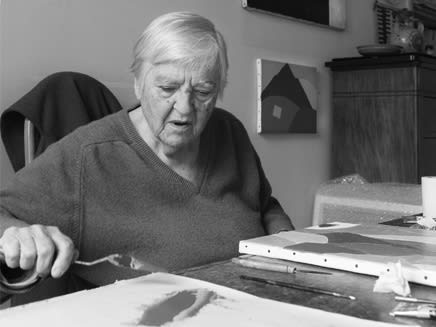
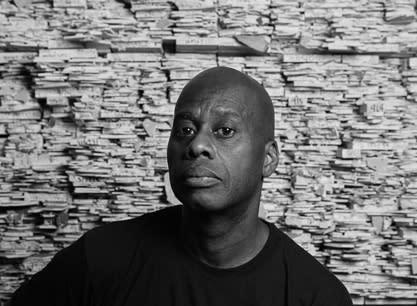
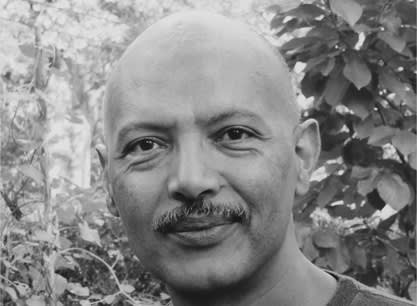
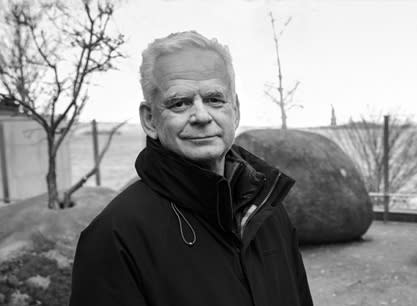
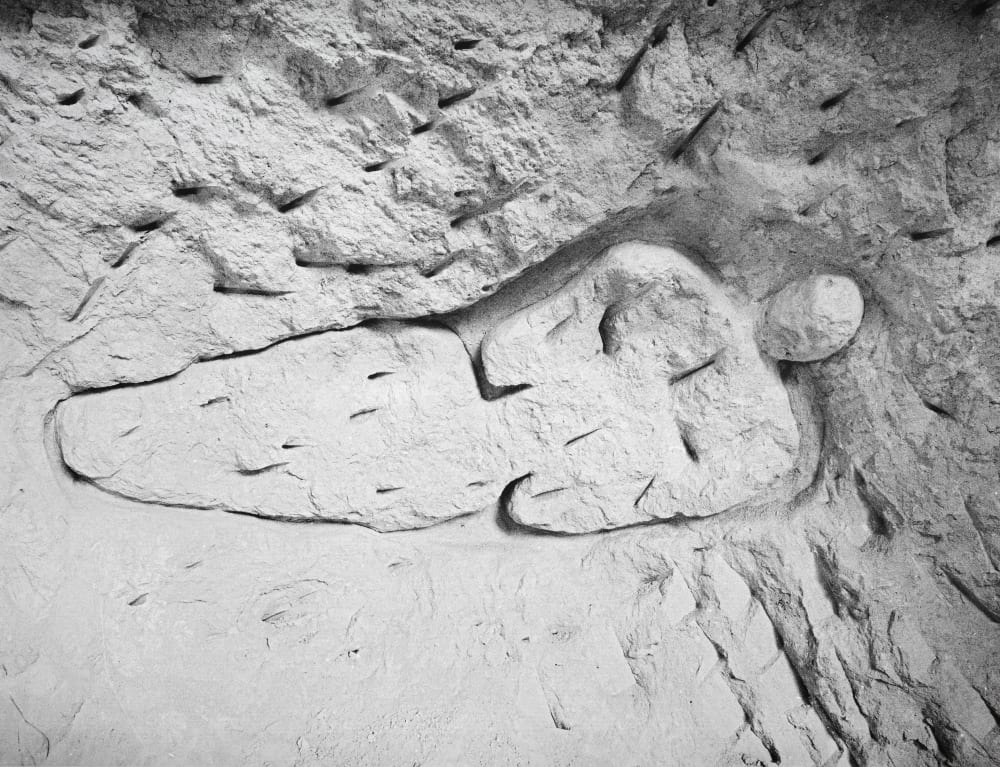
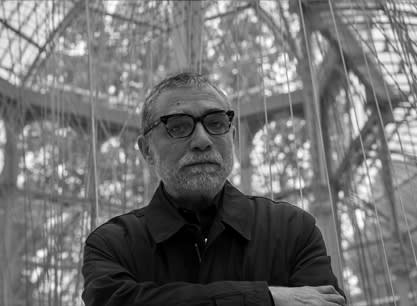
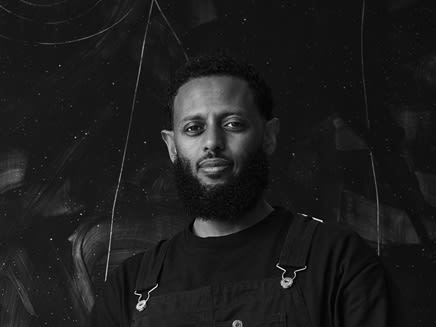
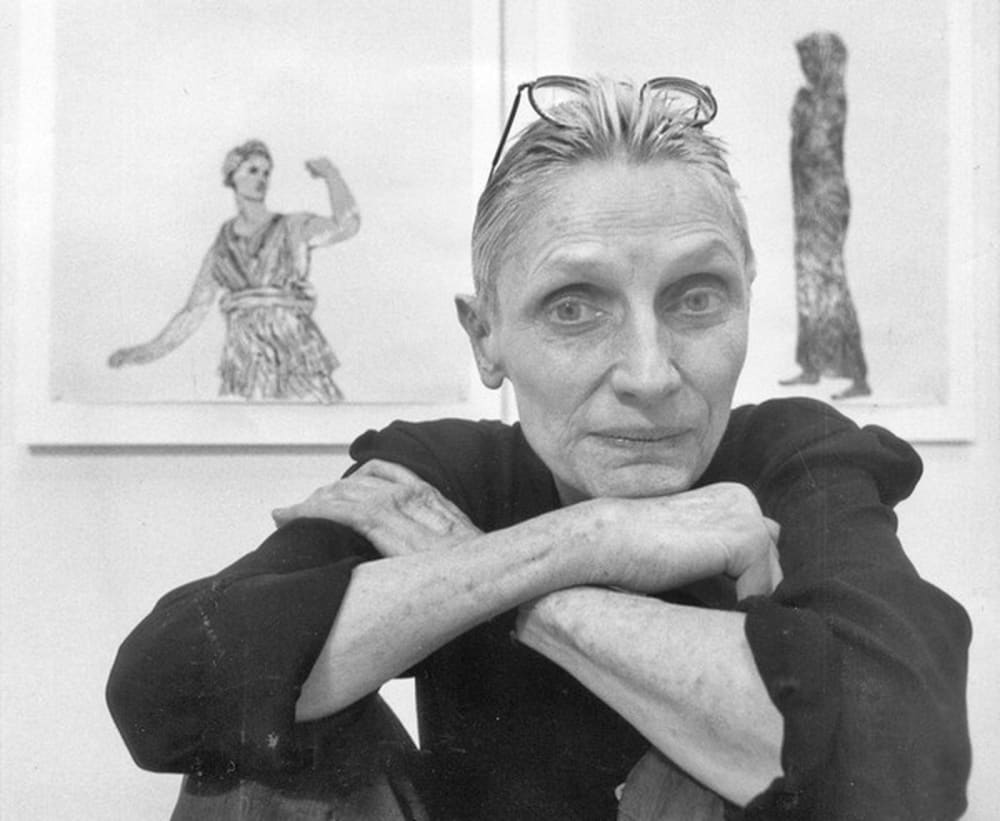
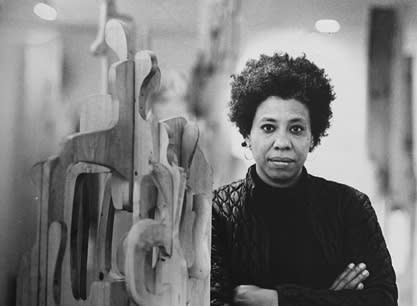
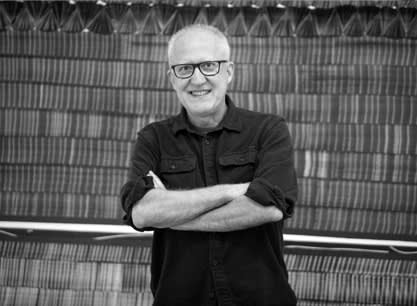







![Zilia Sánchez El silencio de la brisa, 2018 Acrylic on stretched canvas 18 x 36 x 5 inches (45.7 x 91.4 x 12.7 cm) (GL12739) Sánchez achieves crescent-like curvatures and anatomical protrusions by stretching canvas over hand-molded wooden armatures, resulting in artworks that imbue painting with sculptural and architectural sensitivity. El silencio de la brisa [The Silence of Breeze] employs a deep, more saturated, blue as evolved from previously muted palettes, in a composition that is evocative of both natural and corporeal landscapes. Zilia Sánchez’s work is characterized by her distinctive approach to formal abstraction through the use of undulating silhouettes, muted color palettes, and a unique, sensual vocabulary. She is primarily recognized for her shaped canvases, first created in Havana in the 1950s and further developed while living in Havana, New York City, and Madrid. Sánchez’s signature style consists of stretching canvas over hand-molded wooden armatures and painting them with acrylic. Over her 65-year career, Sánchez has explored the juxtapositions between the feminine and the masculine, the painterly and the sculptural, the personal and the universal, the exterior body and the interior self. The reduced color palettes in her compositions as well as the serial processes she employs, connect her to Minimalism, though the sensuality and embrace of the curve in her work bear witness to the distinct language Sánchez has developed. The artist’s first full retrospective, Zilia Sánchez: Soy Isla, was recently organized by the Phillips Collection, Washington DC and traveled to El Museo del Barrio, New York and Museo de Arte de Ponce, Puerto Rico. Her work was included in the 57th International Art Exhibition – La Biennale di Venezia, VIVA ARTE VIVA, curated by Christine Macel. Sánchez’s work is included in international museum and public collections including the Colección Isabel y Agustín Coppel, Mexico City, Mexico; El Museo del Barrio, New York, New York; Israel Museum, Jerusalem, Israel; Museo de Arte de Ponce, Puerto Rico; Museum of Contemporary Art, Chicago, Illinois; Colby College Museum of Art, Waterville, Maine; Museum of Latin American Art in Buenos Aires MALBA, Argentina; Museum of Modern Art, New York, New York; National Museum of Fine Arts in Havana, Cuba; Perez Art Museum Miami, Florida; Princeton University Art Museum, New Jersey; Rose Art Museum, Brandeis University, Waltham, Massachusetts; Solomon R. Guggenheim Museum, New York, New York; Tate, London, England; and The Phillips Collection, Washington, DC. The artist lives and works in San Juan, Puerto Rico, where she permanently settled in the early 1970s. She was born in 1926 in Havana, Cuba.](https://artlogic-res.cloudinary.com/w_600,c_limit,f_auto,fl_lossy,q_auto/ws-galerielelong/usr/exhibitions/images/feature_panels/232/flstanda3-8.jpeg)




